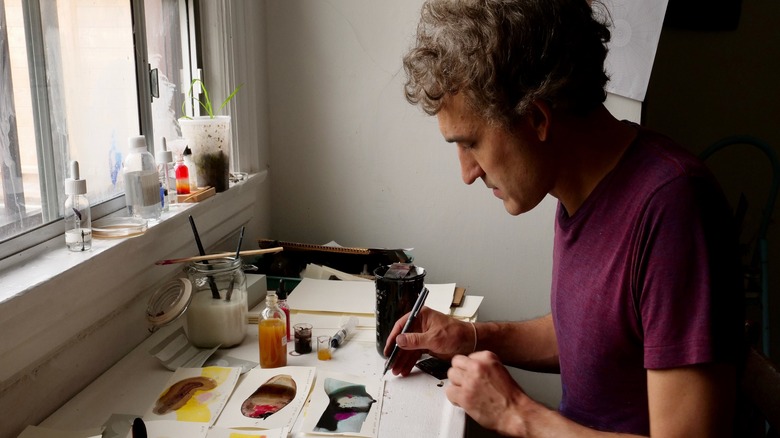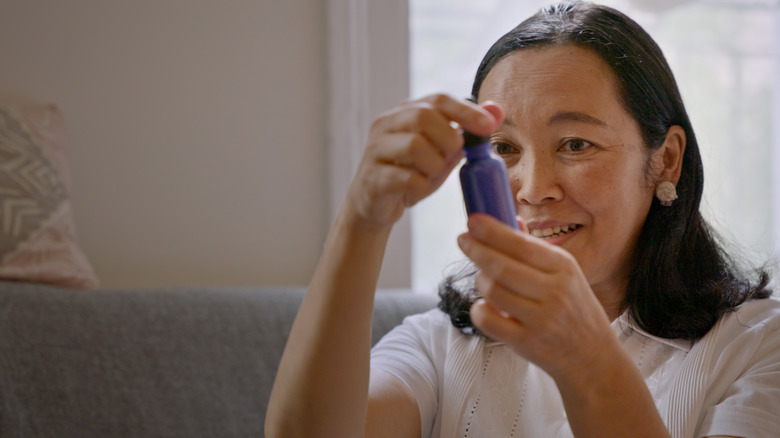The Colour Of Ink Review: Celebrating Ancient Art As Medicine [TIFF]
If I was an art teacher, I would make "The Colour of Ink" part of my curriculum every year. The documentary, which premieres at the 2022 Toronto International Film Festival (TIFF), is one of those humble, understated gems that could easily be missed in the hustle-and-bustle of flashier, sexier films. The subject matter isn't exactly tantalizing — how does one make a 105-minute film about small-batch ink-making interesting? Film-critic-turned-director Brian D. Johnson has figured out the answer: You don't make a movie about the ink, you make it about the people.
"The Colour of Ink" centers on Jason Logan, a former illustrator for The New York Times, who is now an independent ink-maker in Toronto, Canada. Rather than go into the history of ink usage, mass production, or even some diatribe about how pervasive ink still is in our everyday lives, the documentary instead zeros in on Logan's personal experiences and relationships. The film is essentially several vignettes, with each focusing on a different artist (or in the case of Margaret Atwood, a celebrity) connected to artisanal ink in some way.
It's not a linear story, but instead, a fascinating exploration of ideas, connected via the Toronto ink-maker — and despite the limited perspective, the documentary is international, celebrating art from all over the world. Logan creates a traditional black ink for Japanese calligrapher Koji Kakinuma to experiment with; he visits Mexico to learn about red cochineal dye making, and he sends ink to the British Islamic calligrapher Soraya Syed. At one point, Logan even goes into the history of Prussian blue while making a custom ink for artist Yuri Shimojo. All these people come from vastly different backgrounds, but they share a passion.
'Living Ink'
"The Colour of Ink" might be one of the most effortlessly beautiful documentaries I've ever watched — through Johnson's eyes, cliff faces, ocean sunsets, and city streets are just as beautiful as the artwork celebrated throughout. Vivid, expressive shots force you to confront the nuances, imperfections, textures, and pure spirit of the world around us. Great attention is paid to capturing the processes as much as possible, whether it be Jason Logan gathering materials from the woods, or tattoo artist Roxx working on a piece, wiping away droplets of blood and ink off her client's skin. It's a surprisingly tactile film (so many shots of Logan spreading ink with his fingertips!) and that really forces the viewer to confront the effort behind the craftsmanship and artwork. As Logan tells Canadian author Margaret Atwood, he creates "living ink" — it's not as stable or reliable as the stuff you buy at Walmart, but that's the whole point. It's unique. It changes. It's "alive."
The film is packed with delightful imagery that is constantly reinforcing themes of natural grandeur and human wonder, juxtaposed with deeply personal and intimate moments. In one scene, a woman stands in an old marble quarry, her tiny frame flanked by two massive walls of straight white stone. In the next, Logan quietly sits at his cozy in-home workstation, mixing the marble powder into a bright white ink. Later, we get to see classically trained Islamic calligrapher Soraya Syed using the specially made white ink for a project steeped in her Arabic heritage. This journey from awe-inspiring nature to individual craftsmanship to artwork as spirituality is a pattern repeated throughout "The Colour of Ink," and the message is clear: humankind is so small in the grand scheme of things, and art helps us stay grounded. Art connects us to our past and our future. Art is medicine.
Ink is a part of our human history — practically in our DNA — but thanks to industry and mass production, we've lost touch with that part of ourselves. In 2022, with the rise of soulless, deeply ugly NFTs and fears about AI Art Generators displacing designers, it feels so prescient to take a step back and look at something we all take for granted every day: the color of ink.
/Film rating: 8.5 out of 10

